by Lisa Cooke | Mar 20, 2017 | 01 What's New, DNA |
Your DNA test results come with raw DNA data. This raw data is the next piece in your DNA puzzle. Your DNA Guide, Diahan Southard, shares some interesting facts about raw DNA data and its use. Dig in and learn why!
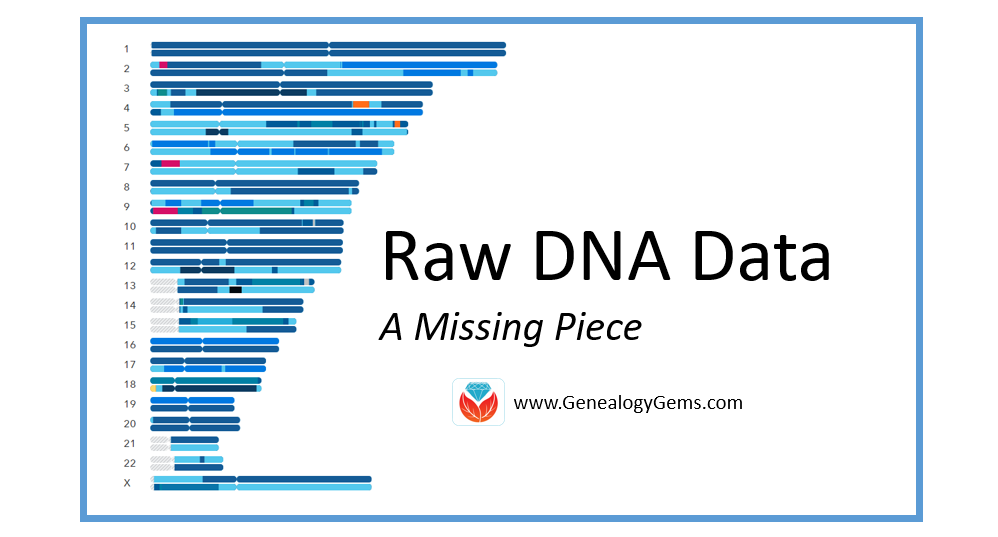
What is Raw DNA Data?
Raw DNA data is the actual output file created by the DNA testing company. You can access your raw data at each testing company, and I strongly encourage that you do. You will need to download and save your raw data results to your computer. For instructions on how to do this, head on over to this page on my Your DNA Guide website.
This file contains your little DNA values at over 700,000 locations tested by your testing company. Any company with the right set-up and analysis tools can help you find matches with other people, and make additional genealogical discoveries. They may also be able to tell you if you like cilantro and are likely to have high blood sugar!
Raw DNA Data Research Projects and Destinations
Raw DNA data has to have a place to go. There are several research projects underway that utilize your data from any of the big four testing companies (Family Tree DNA, 23andMe, MyHeritage DNA, and AncestryDNA) for various genealogical or genetic purposes.
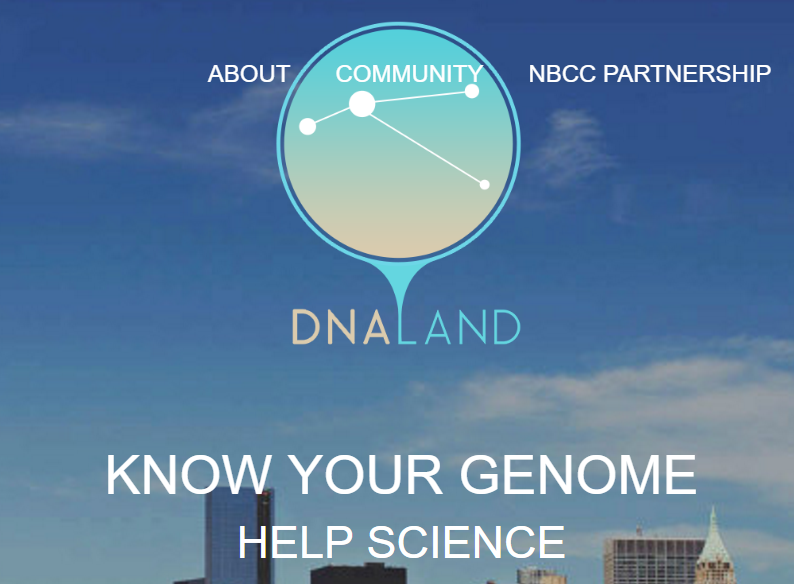
Home page of the DNA Land website
Let’s look at four examples of places you might upload your raw DNA data.
1. Family Tree DNA. If you have tested at 23andMe or AncestryDNA, you can transfer your raw data file to Family Tree DNA for free! You can access all of your matches and use the matching tools. For an additional $19, you can get access to the ethnicity features and other tools.
2. DNA Land. The not-for-profit DNA Land has over 26,000 individuals who have voluntarily uploaded their autosomal DNA test results into their website to be used for research purposes. Their self-stated goal is to “make genetic discoveries for the benefit of humanity.”
3. MyHeritage. MyHeritage also accepts your raw DNA data for incorporation into their genealogical database. You can upload your results for free and receive access to matches along with the ability to contact them. For a one-time fee of $29, you can unlock access to all of MyHeritage DNA’s features and tools as well. Learn more and upload your data here.
4. Geni.com. Geni.com (a family tree collaboration tool) jumped on the DNA bandwagon and announced they too would be integrating DNA into their family tree tool. Utilizing a partnership with Family Tree DNA, Geni.com is utilizing all three kinds of DNA (autosomal, YDNA, and mDNA) in their offering. The interface looks much like what you would see at your testing company: a list of matches with some family tree information.
The biggest takeaway from the recent influx of destinations for your raw DNA data shows us that the integration of DNA into genealogy is in full swing. I estimate every genealogy company and every major genealogy software will offer some kind of DNA integration within the next five years. DNA has certainly earned a permanent spot as a genealogical record type!
A Word of Caution
With all of these options available, and surely more to come, you will want to be careful about who you are giving your raw data to. Make sure you are comfortable with the company and its goals. Be sure you understand what role your DNA will be playing in their research, as well. These are exciting times in the world of genealogy.
Take the Next Steps in Your DNA Journey
 Wherever you are in your DNA journey, we can help!
Wherever you are in your DNA journey, we can help!
Take your very first steps and learn how to get started using DNA testing for family history.
If you have already taken the plunge, learn how to harness the power of DNA matching.
For the most help in understanding DNA for family history, take a look at the ten different DNA guides in both print and digital form from Your DNA Guide, Diahan Southard.
by Lisa Cooke | Jul 27, 2013 | 01 What's New, Findmypast, Research Skills
 If you’ve ever used the Periodical Source Index (PERSI), you know what a genealogy gem it is. PERSI is a master index to thousands of genealogical and historical periodicals, published by the Allen County Public Library’s Genealogy Center (ACPL). According to the Journal Gazette, PERSI contains about 2.5 million citation and adds another 100,000 a year. This is where you go to see if someone’s written about your family or ancestral hometown in state, regional, ethnic, local and other journals and newsletters.
If you’ve ever used the Periodical Source Index (PERSI), you know what a genealogy gem it is. PERSI is a master index to thousands of genealogical and historical periodicals, published by the Allen County Public Library’s Genealogy Center (ACPL). According to the Journal Gazette, PERSI contains about 2.5 million citation and adds another 100,000 a year. This is where you go to see if someone’s written about your family or ancestral hometown in state, regional, ethnic, local and other journals and newsletters.
You can currently search PERSI through the HeritageQuest Online databases at your local library and with your Ancestry.com membership. But the trick is accessing those articles once you find them. The best way right now is to order them directly from ACPL (click on Article Fulfillment Form). It costs $7.50 USD to order up to 6 articles at a time, plus $.20 per page and you get the articles in the mail.
Now findmypast.com has big plans to make PERSI easier to use. Findmypast.com is becoming the new online host of PERSI, and they plan to link digital images of as many articles as possible to the index. “PERSI unearths hidden gems for genealogy researchers,” says D. Joshua Taylor, lead genealogist for findmypast.com. “We look forward to working with various societies and publications to get permission to digitize their articles.”
That sounds like an enormous undertaking, but certainly one that’s long overdue and will pay off for family history researchers. I’ll keep you posted on their progress!
by Lisa Cooke | Sep 9, 2014 | 01 What's New, Ancestry, Beginner, Family History Podcast, Trees
Family History: Genealogy Made Easy Podcast
with Lisa Louise Cooke
Republished 2014

with Lisa Louise Cooke
https://lisalouisecooke.com/familyhistorypodcast/audio/fh44.mp3
Download the Show Notes for this Episode
Welcome to this step-by-step series for beginning genealogists—and more experienced ones who want to brush up or learn something new. I first ran this series in 2008-09. So many people have asked about it, I’m bringing it back in weekly segments.
Episode 44: Family Secrets in Genealogy Records
Today’s episode is unlike any other I’ve done on the podcast. Today we are going to tackle some difficult subject matter: family secrets in genealogy. You know, none of us have a perfect family tree. In fact, I would venture to guess that at some point each one of us who are delving into our family’s past will come across some sad and painful stories. An ancestor abandoned at an asylum, incarcerated for acts of violence, or perhaps who committed suicide.
For Crystal Bell, my guest on today’s show, that sad and painful story was very close to her branch of the tree. In fact, the troubles lay at her parents’ door, and she bore the brunt of the chaos that was created. And yet there is tremendous hope that comes from Crystal’s story. She is a wonderful example of the freedom that can come from facing your fears and breaking down the mystery of a troubled past. It’s what I call the redemptive gifts of family history.
Crystal also shares some of the research strategies that her co-workers at Ancestry.com gave her for taking the next steps in finding her mother, who passed away under an assumed name.
Thoughts from Crystal on responding to the family secrets in your own tree:
“Hatred and resentment only make you look older. They have a great toll on your health. As far as I’m concerned, I can’t hate my mother and father because I don’t know their circumstances were. I can only try to determine their ancestors. I want to know who were my ancestors. Where did they come from?
I feel badly when people…just don’t want to know. I don’t want to die with that sense of abandonment. I want to move on, I want to get past the grief. I want to know who my people were. I just, for the first time in my life, want to experience a feeling of joy and happiness that I feel like I deserve.”
Ancestry.com “Shaky Leaf” Hints Technology
Crystal made connections on her Ancestry.com family tree by reviewing the automated hints provided on the site, known popularly as “shaky leaves.” Learn more about using these in this video.
MyCanvas Update
The MyCanvas service mentioned by Crystal is no longer offered by Ancestry.com. But it is still around! Learn more in my blog post about it.
Here’s a final family history thought for today:
We are not just defined by one relative, or the product of a dysfunctional family or parental relationship. We come from all of our ancestors….
The ones who did amazing things,
The ones who did everyday things,
And the ones who did wrong.
You deserve to know them all, and as the saying goes, the truth will set you free.
by Lisa Cooke | Nov 13, 2017 | 01 What's New, Military, United States
Compiled Military Service Records are core genealogical documents for your ancestors’ military service for the Revolutionary War, War of 1812, Indian Wars, Mexican Wars, Civil War, and the Spanish-American War. Expert Michael Strauss tells us what’s in them and how to find them.

What’s in Compiled Military Service Records
Compiled Military Service Records (often abbreviated as CMSR or CSR) are the records that may exist for your ancestors who served in the U.S. military from the Revolutionary War to the end of the Philippine Insurrection and Spanish-American War. This set of records represents the volunteer Army and doesn’t include regular Army enlistments. Except for limited records of the Revolutionary War and the War of 1812 for the Navy, the other branches of the military (including Navy, Marines, and Revenue Cutter Service) all have their equivalent set of records.
Information you may find in Compiled Military Service Records varies greatly from each of the war periods. They typically contain:
- name, unit, and period of service of the veteran
- muster in/out information
- rank in/out details
- details of the soldier’s career: promotions, prisoner of war memorandums, casualties, and a number of personnel papers which may include enlistment papers and other related documents
- for several of the war periods, physical descriptions of the soldiers including name, age, nativity, occupation, height, hair, eyes, and complexion information
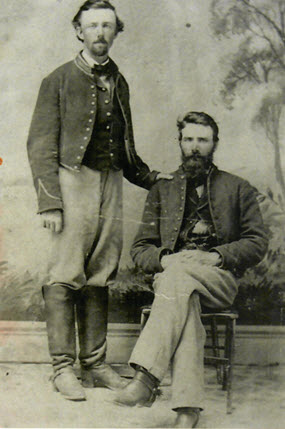
John H Lemaster. Photo courtesy of Michael Strauss.
Your ancestor may have multiple entries in Compiled Military Service Records. This could occur if a soldier served in more than one unit, or in the case of John LeMaster, if he enlisted in two different armies during the Civil War! The Civil War divided our nation, testing the loyalty of all persons who lived during this time. Lemaster chose the Confederacy, at least initially, when he enlisted with the 2nd VA Infantry in 1861 in Charlestown, VA. He fought alongside his Brigade commander, Thomas J. Jackson, who later would be known as “Stonewall Jackson.”
After the Confederate loss at the battle of Gettysburg, he deserted and lived in Martinsburg in what was now West Virginia, where on his draft registration he was listed as a deserter from the Rebel Army. In 1864, he enlisted in the United States Army with the 3rd WV Cavalry, serving out the duration of the war until 1865. After the war, he was granted a federal pension, with no mention of his former service in the Confederacy.
Here are his military service records for both the Confederate and Union armies:
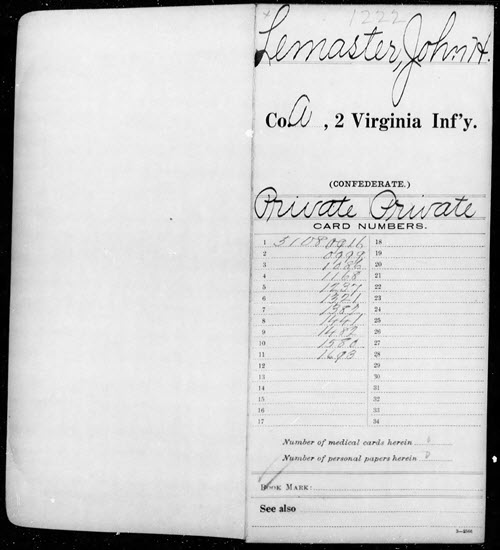
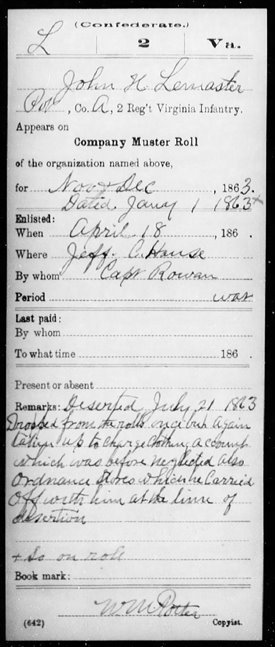
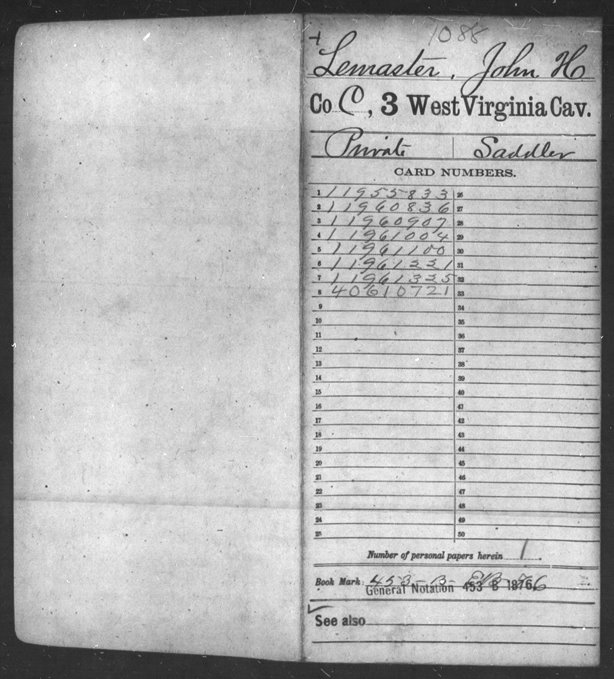
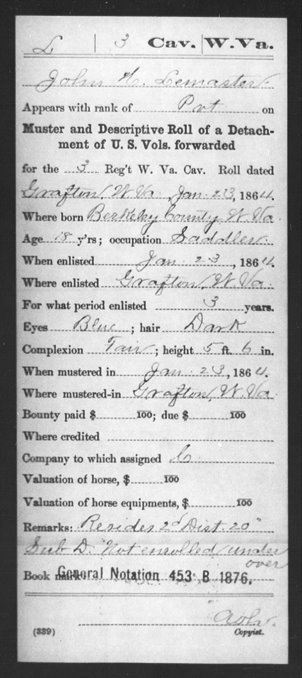
Where to Find Compiled Military Service Records
You may access various CMSR indexes and images online. Here are links to collections at subscription websites Fold3, Ancestry.com and even a couple at the free FamilySearch.org:
Compiled Military Service Records at fold3:
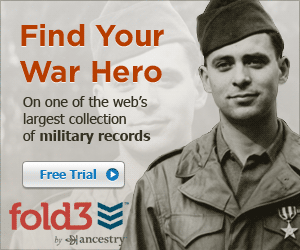 Revolutionary War. Compiled Military Service Record images for CT, DE, GA, MD, MA, NH, NJ, NY, NC, PA, RI, SC, VT, VA, and Continental Troops. Genealogists should also search the local state where their ancestors were from as some Militia isn’t included in these records. During the Revolutionary War additional Compiled Service Records were completed for the Navy, which was broken down to include Naval Personnel, Quartermaster General, and Commissary General Departments. One additional set of CMSR images covered Revolutionary War service along with Imprisonment Cards.
Revolutionary War. Compiled Military Service Record images for CT, DE, GA, MD, MA, NH, NJ, NY, NC, PA, RI, SC, VT, VA, and Continental Troops. Genealogists should also search the local state where their ancestors were from as some Militia isn’t included in these records. During the Revolutionary War additional Compiled Service Records were completed for the Navy, which was broken down to include Naval Personnel, Quartermaster General, and Commissary General Departments. One additional set of CMSR images covered Revolutionary War service along with Imprisonment Cards.- Old Wars (1784-1811). After the Revolutionary War, the newly formed United States government sought to maintain a regular Army. However, volunteer soldiers who served from 1784-1811 were recorded. (One of the reasons for volunteers to be called up would have included the Whiskey Rebellion of 1793.) Their Compiled Military Service Record full images are available here.
- War of 1812. Compiled Military Service Records Indexes for CT, DE, DC, GA, IL, IN, KY, LA, MD, MA, MI, MS, MO, NH, NJ, NY, NC, OH, PA, RI, SC, TN, VT, VA and also the Cherokee, Chickasaw, Choctaw, Creek, and Shawanoe Indians along with United States Volunteers. Full copies of CMSR are online for the Chickasaw and Creek Indians, along with the men from buy herpes medication online uk Lake Erie and Mississippi.
- Indian Wars. Compiled Military Service Records Indexes for the various Indians wars from 1815-1858.
- Mexican War. Compiled Military Service Record indexes for AL, AR, CA, FL, GA, IL, IN, IA, KY, LA, MD, DC, MA, MI, MS, MO, NJ, NY, NC, OH, PA, SC, TN, TX, VA, WI, and the Mormon Battalion and the United States Volunteers. Full copies of the CMSR are online for AR, MS, PA, TN, TX, and the Mormon Battalion.
- Civil War. Click here to search. Union: Indexes for AZ, CA, CO, CT, IL, IN, IA, KS, ME, MA, MI, MN, MO, NH, NJ, NY, OH, PA, RI, VT, WA, WI, United States Veteran Volunteers, and Veteran Reserve Corps. Full copies of CMSR for AL, AR, CA, CO, Dakota Territory, DE, DC, FL, GA, KY, LA, MD, MA, MS, MO, NE, NV, NM, NC, OR, TN, TX, UT, VT, VA, WV, United States Colored Troops, United States Volunteers, and 1st NY Engineers. Confederate: indexes are online for AL, and VA. Full copies of CMSR are online for AL, AZ, AK, FL, GA, KY, LA, MD, MO, MS, NC, SC, TN, TX, VA, Miscellaneous, Volunteers, Indians, and Officers.
- Spanish American War. Compiled Military Service Record indexes for AL, AR, CA, CO, CT, Dakota Territory, DE, DC, FL, GA, ID, IL, IN, IA, KS, KY, LA, ME, MD, MA, MI, MN, MS, MO, MT, NE, NV, NH, NJ, NY, NC, ND, OH, OK, OR, PA, PR, RI, SC, SD, TN, TX, UT, VT, VA, WA, WV, WI, WY, and United States Volunteers. Full copies of CMSR are online for FL.
Compiled Military Service Records At Ancestry.com:
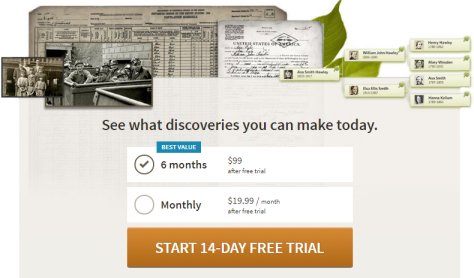 Revolutionary War. Full copies of the Compiled Military Service Records for CT, DE, GA, MD, MA, NH, NJ, NY, NC, PA, RI, SC, VT, VA, and Continental Troops. (This database often doesn’t list the local militia, as most of the men listed were part of the continental line. Researchers search by keyword or location.)
Revolutionary War. Full copies of the Compiled Military Service Records for CT, DE, GA, MD, MA, NH, NJ, NY, NC, PA, RI, SC, VT, VA, and Continental Troops. (This database often doesn’t list the local militia, as most of the men listed were part of the continental line. Researchers search by keyword or location.)- Old Wars. An index and full images of the Compiled Military Service Records of those men who served after the Revolutionary War and before the War of 1812, covering the years of 1784-1811.
- War of 1812. Abstracted lists of names, state, and military units from the Compiled Service Records (no images).
- Indian Wars: Database with images for Florida: includes the Florida Wars, Second Creek War, and the Third Seminole War from 1835-1858.
- Mexican War. Full copies of the CMSR for MS, PA, TN, TX, and the Mormon Battalion.
- Civil War: Indexes to Union Compiled Military Service Records and Confederate Compiled Military Service Records. An additional set of Service Records comes from units that were raised by the Confederate Government and not from any of the states that comprised the Confederacy; you can view the images and search by military unit.
- Spanish American War. Compiled Military Service Record Indexes cover the same geographical areas as on Fold3. Full copies of CMSR are online for Florida.
Free Compiled Military Service Records at FamilySearch.org:
FamilySearch has fewer Compiled Military Service Records that include images. One of the major collections includes the Revolutionary War CMSR’s that when searched here, the images provide a direct link to Fold3.
Most of the other major war periods are microfilmed and available at the Family History Library in Salt Lake City, Utah. With online access through both Fold3 and Ancestry provided on the computers in the library, though, accessing the film is less desirable. Click here to learn more about changes in microfilm lending at the Family History Library.

Michael Strauss contributes the Military Minutes segment on Lisa Louise Cooke’s Genealogy Gems Podcast. In the recently-published Episode 211, he profiles the 20th-century replacement for Compiled Military Service Records: the Official Military Personnel File. Click here and listen for free!
Disclosure: This article contains affiliate links and Genealogy Gems will be compensated if you make a purchase after clicking on these links (at no additional cost to you). Thank you for supporting the free Genealogy Gems podcast and blog!
by Lisa Cooke | May 23, 2013 | 01 What's New, Military
Here’s the latest from the National Archives:
National Archives Marks 150th Anniversary of U.S. Colored Troops

Sic semper tyrannis – 22th Regt. U.S. Colored Troops, 1864. Bowser, David Bustill, 1820-1900 , artist
Washington, DC. . . Marking (the) 150th anniversary of its creation, the National Archives announces the completion of the United States Colored Troops (USCT) Service Records Digitization Project, in partnership with Fold3. For the first time, this collection – nearly four million images of historic documents with detailed information on former slaves – is available online to anyone, anywhere.
On May 22, 1863, the War Department issued General Orders 143, establishing a Bureau of Colored Troops in the Adjutant General’s Office to recruit and organize African American soldiers to fight for the Union Army. These service records – including those of the men of the famed 54th Massachusetts Infantry featured in the movie Glory – are a treasure trove for genealogists and a rich source of documentation on the black experience in America during the Civil War.
Researchers may be surprised to find that the USCT military service records hold not only muster rolls but also a huge array of personal papers that can include enlistment papers, correspondence, orders, prisoner-of-war memorandums, casualty reports, and final statements. Starting in October 1863, slave owners could enlist their slaves and receive up to $300 upon filing a “manumission” or deed of ownership. Unique to some of the records of the USCT are these deeds of manumission and bills of sale. For genealogists, these records may offer the only source of documentation of an enslaved ancestor in the absence of other vital records.
For the first time, these valuable historical records are available online, thanks to Fold3, and to National Archives staff and volunteers who spent years preparing, preserving, microfilming, and digitizing them. The collection is available free of charge to non-subscribers on www.fold3.com/category_268 today through May 31, and can be accessed for free at any time on computers at National Archives research facilities nationwide.
In total, the USCT consisted of seven cavalry regiments; 13 artillery regiments plus one independent battery; 144 infantry units; two Brigade Bands; and other miscellaneous smaller units. Records are arranged by regiment and then alphabetically by surname of the soldier.
The USCT fought in 39 major engagements and more than 400 other ones. Sixteen African American soldiers received the Medal of Honor. The last USCT regiment was mustered out of Federal service in December 1867.
One soldier chronicled in the records is Edmund Delaney, a slave who served in Company E of the 117th USCT Infantry. Delaney was 25 years old when he enlisted in August 1864. His owner, Harvey C. Graves of Georgetown, Kentucky, filed a compensation claim for Delaney’s military service in December 1866, stating that Delaney was “purchased at private sale when he was quite a small boy.” Graves attached to his “proof of ownership” a rare photo of Delaney, and letters Delaney had written to him while serving in Brownsville, Texas.
Another soldier’s file reads like an ultimate page turner and details the tragic story of Fortune Wright, a free black man before the Civil War who served in the 96th USCT Infantry. Read USCT project manager Jackie Budell’s fascinating Prologue “Pieces of History” blog post.
More information:

 Wherever you are in your DNA journey, we can help!
Wherever you are in your DNA journey, we can help!












